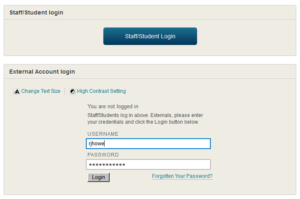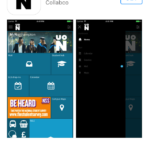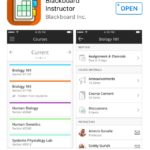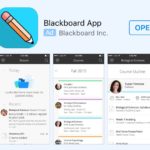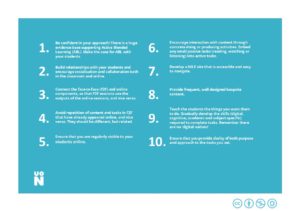We have just enabled an improved way for staff and students to login to NILE. The screen below shows the new Single Sign On (SSO) button which you will now see on the NILE login screen. By clicking onto this button, your machine will try to log you in using details already held on your computer. If it fails then it will just ask you to type in your normal username and password.
The box below this is actually the same box that was previously on NILE and this will also work if your type in your details in the old way. If the new button does not immediately work then you may just need to clear your browsers cookies using the details at the bottom of this message.
Clearing your browser cookies
If you receive an error when trying to log in, it may help to clear your browser cookies. When doing so, ensure you don’t select other items that you want to keep. For example, you may wish to keep saved passwords and your browsing history.
- The keyboard shortcut for Firefox, Chrome and Internet Explorer is ctrl+shift+delete. For Safari it is ctrl+alt+e.
- If you are unsure on how to clear cookies for your particular browser, please refer to the browser’s own website for help.
Following on from the Learntech team success in the ALT awards 2014, a recent submission for 2017 has confirmed that the Learntech team at The University of Northampton is still one of the best teams in the sector.
On Wednesday 6th September, 2017 at the Association for Learning Technology gala dinner, the Northampton LearnTech team won the runner-up award for “Team of the Year 2017″.
The Award’s overall purpose is to celebrate and reward excellent practice and outstanding achievement in the learning technology field and is open to individuals and teams based anywhere in the world.
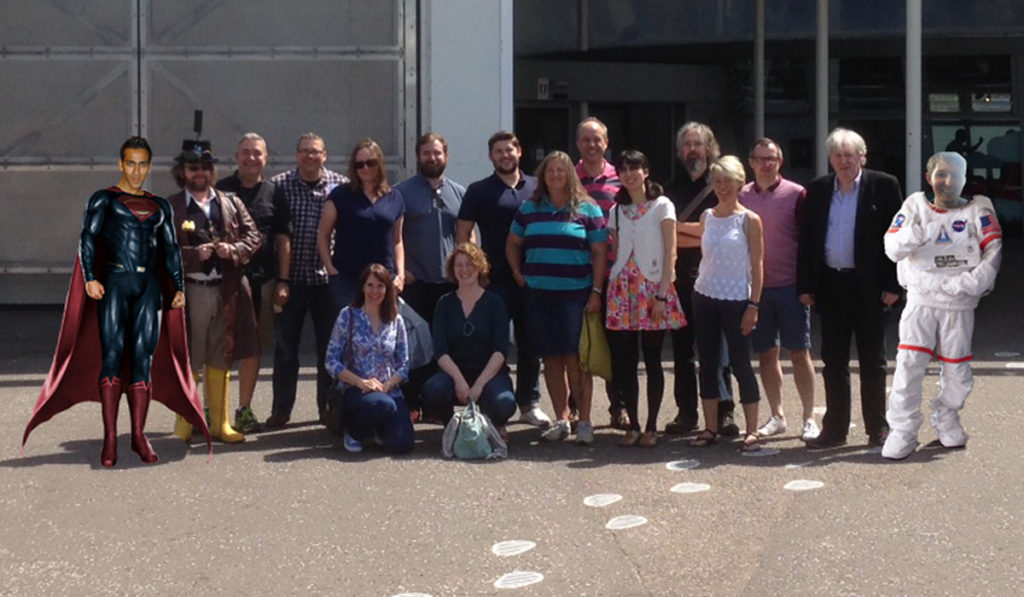
Learntech team 2017 - Back row: Omar Ahmedmia, Jim Harris, Al Holloway, Richard Byles, Julie Usher, Tim Guyett, Craig Ball, Anne Misselbrook, Rob Howe, Sharon Song, Rob Farmer, Vicky Brown, Iain Griffin, Andy Stenhouse, Kieran McGovern (in spacesuit). Front row (kneeling): Belinda Green and Elizabeth Palmer
This award recognised the incredible work and progress made by the team over the past few years and the contribution which they have made to the environment within Northampton in addition to advancing the Learning Technology field more generally.
As part of the application process a group of key staff within the University of Northampton had to talk about the impact which the team had made on their own particular area.
In addition, the team also made a film about the work which they do:
https://youtu.be/Egv6bXEng_c
In accepting the award, Rob Howe (Head of Learning Technology) stated that:
“The Learning Technology Team has grown from being a peripheral group to a major force for positive change within the University, its academic partners and the sector. This has been due to the drive, determination and interpersonal skills which are prevalent within the team which has enabled it to encourage staff and students to recognise the value of research informed Learning Technology.
Many aspects of University activity now including Learning Technology:
– Highly functional accessible VLE developed in conjunction with staff and students
– Development of quality mechanisms to better capture feedback and reward engagement
– Engagement in international collaborative bids
– Close links with the Student Union
– Enhancing core University data (e.g. Student Record System)
– Informing the development of new campus (Waterside)
– Leading on the design of new programmes for the University based around Active Blended Learning (ABL)
– Sector contributionsWhilst many Learning Technology Teams will be expected to be successful in the above activities – the group of Northampton should be recognised with the significant progress which has been made in the very wide areas of responsibility covered by their work and the enthusiasm generated within the staff and student body as a whole.”
The whole of the Team is proud to be acknowledged as a leading light within the Learning Technology profession, at the heart of a TEF Gold class University.
As a result of the University’s Active Blended Learning strategy, some teaching staff are considering using some contact time to support learners in the online environment as well as in the classroom. There are many reasons why you might choose to do this: perhaps you want to increase the flexibility for your cohort so they don’t have to travel; perhaps you need to help your students develop their digital literacy; perhaps running a teaching session online allows you to do something you couldn’t do in the classroom (like including a guest speaker, or allowing students time to draft and revise before sharing their thoughts). Or perhaps you just want to add some more structure, guidance and feedback to regular independent study activities.
Whatever your motivation, there are some tips that can help you think about how to use that contact time well, and make online learning a rewarding experience for you and your students.
Transparent pedagogy and clear expectations
Recent research with our students highlighted that they don’t always feel prepared for independent study, and often come to university expecting to ‘be taught’ rather than to have to work things out for themselves (the full report can be downloaded here). Scaffolding the development of independent learning skills is a gradual process, with implications for online as well as classroom teaching – particularly as this way of learning may be new to your students too (at least in formal education contexts). So how do you avoid students feeling like they’ve been ‘palmed off’ with online activities, when national level research tells us that many applicants expect to get more class time than they had at school?
 It’s worth setting time aside early on to have frank conversations about how learning works at university level, and about how the module will work, but also about why those choices have been made. Students can sometimes be unaware of the level of planning and design work that goes into a module, so it helps to explain why you’re asking them to do the tasks you’ve planned – in the discussion forum, for example, why is it important for them to engage with opinions or ideas shared by other students? You don’t need to be an expert on social constructivism to explain that learning to research, communicate and collaborate online are crucial skills for graduates. And if it’s the first time you’ve tried something, don’t be afraid to say so, and acknowledge that you’re learning together! Keeping the conversation open for feedback on teaching approaches will help improve them in the future.
It’s worth setting time aside early on to have frank conversations about how learning works at university level, and about how the module will work, but also about why those choices have been made. Students can sometimes be unaware of the level of planning and design work that goes into a module, so it helps to explain why you’re asking them to do the tasks you’ve planned – in the discussion forum, for example, why is it important for them to engage with opinions or ideas shared by other students? You don’t need to be an expert on social constructivism to explain that learning to research, communicate and collaborate online are crucial skills for graduates. And if it’s the first time you’ve tried something, don’t be afraid to say so, and acknowledge that you’re learning together! Keeping the conversation open for feedback on teaching approaches will help improve them in the future.
In conversations about pedagogy, be sure to make space for your students to talk about their expectations and previous experiences. This might help them identify aspirations and areas for development, but it will also inform your planning, and a shared understanding of responsibilities will make the learning process run much more smoothly. Consider co-creating a ‘learning contract’, exploring issues like how often you expect them to check in on social learning activities on NILE, and how (and how quickly) they can expect to get responses to questions they pose there.
Building relationships
A key element of success in any learning environment is trust. This doesn’t just mean students trusting in you as the subject expert, and trusting that the work you’re asking them to do is purposeful and worthwhile (see above). It also means trusting that your classroom (whether physical or online) is a safe space to ask questions, and that feedback from peers as well as from you will be constructive and respectful. Some of this can be explicitly addressed with a shared ‘learning contract’, as above, but it also helps to reinforce this through the learning activities themselves. In the online environment, introducing low-risk ‘socialisation’ activities early on can help to build confidence and a sense of community, which will be invaluable in the co-construction of knowledge later on (see Salmon’s five stage model for more on this). Simple things like adding the first post to kick off a conversation, and explicitly acknowledging anxieties about digital skills, can make all the difference.
 Trust also means students trusting that their contributions in the learning space will be acknowledged and valued. Many online tools, such as blogs and discussion forums, are specifically designed with student contribution as the focus, but with live tools, like Collaborate, you may need to plan activities specifically to support this, so that it’s not just you talking. After all, you wouldn’t expect a discussion forum to be composed of one long post from you, so with live sessions, the same principles apply! (see Matt Bower’s Blended Synchronous Learning Handbook for ideas).
Trust also means students trusting that their contributions in the learning space will be acknowledged and valued. Many online tools, such as blogs and discussion forums, are specifically designed with student contribution as the focus, but with live tools, like Collaborate, you may need to plan activities specifically to support this, so that it’s not just you talking. After all, you wouldn’t expect a discussion forum to be composed of one long post from you, so with live sessions, the same principles apply! (see Matt Bower’s Blended Synchronous Learning Handbook for ideas).
On the flip side of this, you also wouldn’t expect a student who was speaking in a live webinar to keep trying if they didn’t get a reply. So using the same principles, if you’re planning asynchronous (not live) learning activities, make sure you schedule teaching time to review your students’ views and ideas, whether online or in the next face to face session. Online, techniques like weaving (drawing connections, asking questions and extending points) and summarising (acknowledging, emphasising and refocusing) are invaluable, both for supporting conversation and for emphasising that you are present in the online space (see Salmon 2011 for more on these skills).
And if some of your students haven’t contributed, don’t panic! There could be lots of reasons for this. It may be a bad week for them, or a topic they don’t feel confident in, in which case chances are they will still learn a lot from reading the discussion. It may be that someone else already made their point – after all, if you were having a discussion in the classroom, you wouldn’t expect every student to raise a hand and tell you the same thing (if you need to check the understanding of every single student, maybe you need a test or a poll instead of a discussion). If participation is very low though, it may be that you need to reframe the question (as a starter on this, this guide from the University of Oregon, although a little outdated in technical instructions, includes some useful points about discussion questions for convergent, divergent and evaluative thinking).
Clarity, guidance, instructions, modelling
Last but by no means least, with online learning it helps to remember that students need to learn the method as well as the matter. A well-organised NILE site, clear instructions and links to further help will go a long way, but nothing beats modelling. Setting aside time in your face to face sessions to walk through online activities and address questions will save you lots of time in the long run.
The University has a number of relevant mobile apps which have built upon initial developments from 2007. These continue to be updated and evolve – this blog posting will give you a quick update on the most recent changes.
iNorthampton
This was one of the original staff and student apps. It contained links to the staff directory, Blackboard Mobile Learn and maps. Whilst this is still available in the Apple and Play stores it is now unsupported and will be shortly be removed and replaced with MyNorthampton.
This has been developed during 2017 and phase 1 is already available in the Apple, Play and Window stores. It will continue to be enhanced during the year and has a number of features which are of use to staff and students.
This was the original Blackboard (NILE) app which allowed staff and students to work on sites available through NILE. It was removed from the app store from August 2017 and will be unsupported from 31st August 2017. Staff should now use the Blackboard Instructor app and students should use the Blackboard app (previously called Blackboard Student)
This is now a dedicated Blackboard app for staff. It is currently in its first release but will be enhanced with functionality which allows staff to manage their NILE engagements from a mobile device. If you are running Blackboard Collaborate from a mobile device then this app is essential.
Blackboard App (Previously called Blackboard student)
This is now a dedicated Blackboard app for students. It allows students to interact with NILE / Collaborate sessions from their mobile devices. Please be aware if you have previously downloaded Blackboard student then it will be automatically be updated to this app and the icon will change to the pencil (as shown above).
Lynda.com is a huge library of high-quality online video tutorials supporting study skills, digital skills, business skills, employability skills and lots more.
The tutorials are subtitled and include exercise files. On-screen controls mean you decide the pace of your learning, plus you can view content on any device either via your browser or by downloading the app.
This brief 2017 summer update and links to existing postings collates some of the information around Learning Technology which may be useful. If you wish to discuss any of the following then please contact the team to arrange a meetup.
—————-
NILE and training Updates
Module and Programme templates now available within NILE for 2017/18 sites
The new upgrade to Turnitin (Feedback Studio) was released on the 1st August
The training schedule until December 2017 is now available
NILE (Blackboard) is being upgraded on Saturday 12 – Sunday 13 August between 16:30 and 04:30 during which time it will be unavailable. This upgrade just moves us to the latest stable release – there are no significant changes to the interface. Work is currently in progress to enable single sign on and a further update will made before the end of August.
There have been a number of updates to Northampton mobile apps as detailed in this blog posting
Rob Howe from the Learntech team was pleased to be able to present the ‘Best NILE site Student Teaching and Representation Awards’
If you have any questions around ‘unusual’ or innovative NILE sessions then please feel free to contact the team to discuss how to best implement these and how the technology can best support you. The team will investigate questions such as the numbers of students and where they are located; what devices students are using and how they are connected; extra support which may be needed to get you up and running and any additional services such as audio / visual which may be required.
—————-
Team Updates
Check out the recent blog posting to see who is who within the Learntech team
The Learning Technology Team are now through to final round of Association of Learning Technology ‘LearnTech Team of of the Year’ awards. The presentation will be in early September where we will find out what we have been awarded.
—————-
Research Updates
Recent research has just been released around student perceptions & experiences of Active Blended Learning [ABL]
Anne Misselbrook and Melanie Cole blog on the benefits of Xerte developments within a Midwifery course
Student survey results provide encouraging evidence for effectiveness of online learning using Xerte e-learning packages
Update on the Learning Styles debate
The recent Learntech team awayday provided an opportunity to take a picture of all of those present (we had to digitally add two members of the team who were away during the day.)

Learntech team - Back row: Omar Ahmedmia, Jim Harris, Al Holloway, Richard Byles, Julie Usher, Tim Guyett, Craig Ball, Anne Misselbrook, Rob Howe, Sharon Song, Rob Farmer, Vicky Brown, Iain Griffin, Andy Stenhouse, Kieran McGovern (in spacesuit). Front row (kneeling): Belinda Green and Elizabeth Palmer
There is also a linked posting which provides the current areas of responsibilities for the team. If you are not sure who to contact then please refer to this in the first instance.
In the wake of the creation of the new 1718 module sites, we are delighted to announce the unveiling of this year’s programme sites.
Following a recommendation to encourage a more uniform use of and engagement with these sites represented in the paper to SEC in February to help foster student programme identity, a task and finish group was subsequently formed to address what was required within the template. This resulted in the production of a more user-friendly left-hand menu and an updated version of NILE minimum standards to incorporate suggested content for each section. These were finally approved at SEC in May 2017.
A part of producing the updated template was involving colleagues across student facing services: this has allowed us to incorporate some core content for your programme sites in order to enhance the quality/clarity/consistency of information across all sites in all Faculties. We now require the programme leaders and their colleagues to take ownership of these sites and following the guidance, to add programme/ subject specific content for the benefit of your students.
As always, the Learning Technologists are on hand to help you if assistance is required.
On 18th May, 2017, Simon Sneddon was presented with the Best NILE Site Award as part of the Student Teaching and Representation (STAR) Awards evening.
(left to right) Simon Sneddon collecting his award from Rob Howe (Head of Learning Technology)
NILE is an essential part of the student online experience. This award was to recognise staff members who have made a significant effort with their NILE site setup and use.
Students were asked to nominate against the following criteria:
• The site design and navigation assists students to easily find the content they are looking for.
• The content and resources on the site cover all key areas required.
• Tools for discussion and collaboration are effectively used throughout the site.
• Assessment and feedback is clear and well managed through the site.
• The tutor’s Nile Site has an element of innovation which has enhanced engagement
The full list of nominees and the student comments are shown below – congratulations to all of these and to all of the staff that have worked to support them.
Alasdair Gordon-Finlayson
The way Nile is used by Alasdair has been described as “truly innovative” as it is utilising most of the available components of the site. Alasdair uploads slides with voice overs, chapters for reading and videos covering related topics onto NILE which are well appreciated by students. He includes online tests which allow students to receive immediate feedback.
Mark Johnson
Mark provides a huge amount of information onto NILE, but organises it in such a way so that it is not daunting for students. All the content and resources are always uploaded on time so they are easy to find. He talks through all the sites and shows students where to find all the information. Mark utilises message boards to communicate with students and regularly updates these with information on the subject matter and even external job opportunities. All emails are replied to efficiently with the contact information provided on NILE. All feedback and grades are nicely structured so students know where to find all of their grades.
Melanie Cole
Melanie used NILE to create an online resource to prepare students for their practical assessments. She broke each learning stage down by demonstrating it on video, with added sound and commentary. Each element of the practical was explained clearly and then students were tested on it before they moved through the online learning resource. This learning tool was engaging, interesting, clearly explained and easy to follow. Students described it as the best way of learning a complex subject. The video, audio and online test was a fantastic way to reinforce knowledge.
Simon Sneddon
Simon has proactively designed and prepared the NILE site to be ‘Waterside Ready’, and offers a range of resources including videos, books, journals, and examples of previous assignments for guidance. He has striven to ensure that all students are aware of how to use the site by demonstrating it in sessions, and by clearly signposting each section of the modules and related tasks. On the NILE site, there is an online discussion board where students can discuss the topics and share resources covered. Simon frequently comments and posts updates encouraging students to read each other’s work and have a discussion on the issues raised. These tools for discussion and collaboration are highly effective throughout the site, not only because it is a different way of learning, but also it helps face to face students to share, and to read the work of distance learners, bridging the gap between both student groups. All module content is available at the start of term and so students can start planning ahead. Assessments and feedback have designated folders, which provide the breakdown of all assignments in a clear and accessible format.
Toby Purser
Toby uploads links to relevant media currently in the news linking to each topic. He uses a mixture of both interactive and teacher lead learning on the website with e-activities, videos and newspaper articles on NILE building upon content discussed during teaching. Each section of the module is separated into its own folder with a relevant picture which makes information easier to find. Toby uses active discussion boards where topics are tackled prior to the session. As well as written feedback which is easy to find, Toby uploads a 3 minute video clip where he personally talks through the strengths and weaknesses of each assignment and explains how students can improve.
Authors: Elizabeth Palmer, (University of Northampton, Learning Designer,) Sylvie Lomer, (University of Manchester, Lecturer in Education) and Ivelina Bashliyska (3rd Year Undergraduate Student and Assistant Researcher).
With thanks to Nadine Shambrooke and David Cousens for support with transcription and coding.
______________________________________________________________________
The University of Northampton has taken an institutional approach to learning and teaching through the widespread adoption of Active Blended Learning (ABL) as its new ‘normal’. To find out more please visit: https://www.northampton.ac.uk/ilt/current-projects/waterside-readiness/
However, student engagement has been highly variable, which has created a number of challenges for staff. Semi-structured qualitative focus groups have been undertaken with 201 undergraduate students across all the year groups and faculties during the academic year 16/17 based on a pilot study of 24 students in academic year 15/16. These focus groups have been looking at trying to uncover the students own perceptions and experiences of ABL in order to unpick the reasons behind varying patterns and engagements and to glean student insight into the factors that inhibit or encourage engagement with ABL.
The study has revealed a number of key factors which students identify as having significant impact on their engagement. Key success factors include effective pedagogical design, in particular establishing a clear and explicit relationship between online and face to face components of modules, and scaffolding the development of digital skills and literacies in the process of establishing online tasks. A strong relationship between staff and students is also critical, where students trust in the decisions and motivations of staff. This is signalled by following up on online tasks, providing feedback where relevant, and explicitly discussing the value of online tasks to module learning outcomes and employability skills. A key finding is that students’ conceptions of learning, teaching & knowledge impact on their engagement with ABL, and are not necessarily compatible with ABL principles. These factors are complex, interdependent and have varying loci of control. Staff can take a number of measures to increase the likelihood of student engagement, although certain factors remain ultimately within the agency of students. Understanding these issues is critical to the success of ABL.
The following artefacts provide the results of the study to date:
Read the Interim Report from the Main Study here:
For Ten Top Tips on how to design ABL to maximise student engagement:
Read the Pilot Study Report here:
Summer is fast approaching and it’s business as usual in the the LearnTech Team. As this academic year draws to a close, we are already looking ahead and preparing for next year’s teaching. With this in mind, we will be offering our weekly LearnTech lunchtime sessions and other training opportunities on a rolling basis over the summer months, maximising the opportunities for you to engage, pick up new skills and receive the support you need to create inspiring and active teaching content for the benefit of your students. One tool in particular you may wish to familiarise yourself with is Turnitin’s new interface Feedback Studio, due for release from August.
LearnTech lunchtime sessions currently introduce some of our core NILE tools and some specific SaGE elements, including their potential applications and how these technologies can enhance your teaching and learning. Sessions are being offered at Park and we will happily offer parallel sessions at Avenue Campus on a request basis; please contact Vicky Brown, Learning Technology Manager in the first instance.
You can book now and come along to receive updates, refresh your skills and find out how your peers are working using UN-supported LearnTech tools. Feel free to bring along your own lunch to the hour long sessions.
We look forward to welcoming you over the coming weeks. Details, dates and booking links follow:
Kaltura/ MediaSpace (video)
As the University has now moved to a single video solution in Kaltura (MediaSpace), this is a chance for those who have already started to engage with this tool and those as yet to experience it. The following areas may cover an introduction to MediaSpace; video capture using CaptureSpace; uploading video to MediaSpace; embedding video content in NILE; using quizzes in Kaltura.
Monday 5 June – 12:30-13:30 – Park Campus, Library, Tpod
Tuesday 4 July – 12:30-13:30 – Park Campus, Library, Tpod
Tuesday 1 August – 12:30-13:30 – Park Campus, Library, Tpod
Friday 1 September – 12:30-13:30 – Park Campus, Library, Tpod
Tuesday 26 September – 12:30-13:30 – Park Campus, Library, Tpod
Tuesday 24 October – 12:30-13:30 – Park Campus, Library, Tpod
Tuesday 21 November – 12:30-13:30 – Park Campus, Library, Tpod
Please sign up here: http://bit.ly/2fWkTbG
Collaborate (Virtual Classroom)
This session will introduce those new to using online virtual classrooms (Northampton is licensed for Collaborate: Ultra Experience until 2020) as well as for those who are curious to learn about new functionalities now available in the tool. Topics may cover some of the following: setting up the tool in your NILE sites; inviting attendees; sharing files/ applications/ the virtual whiteboard; running a virtual classroom session; moderating sessions; recording sessions; break-out rooms.
Monday 22 May – 12:30-13:30 – Park Campus, Library, IT Training Room
Monday 19 June – 12:30-13:30 – Park Campus, Library, Tpod
Tuesday 18 July – 12:30-13:30 – Park Campus, Library, Tpod
Monday 14 August – 12:30-13:30 – Park Campus, Library, Tpod
Monday 11 September – 12:30-13:30 – Park Campus, Library, Tpod
Monday 9 October – 12:30-13:30 – Park Campus, Library, Tpod
Monday 6 November – 12:30-13:30 – Park Campus, Library, Tpod
Monday 4 December – 12:30-13:30 – Park Campus, Library, Tpod
Please sign up here: http://bit.ly/2eG7mZR
MyPad / Edublogs (blogging tool)
MyPad (Edublogs) is the University’s personal and academic (WordPress) blogging tool and can be used in a number of ways to communicate and share learning resources. Topics covered may include: creation of individual / class student blogs; use of menus/ media; blog administration within modules; creation of class websites.
Friday 30 May – 12:30-13:30 – Park Campus, Library, Tpod
Monday 26 June – 12:30-13:30 – Park Campus, Library, IT Training Room
Monday 24 July – 12:30-13:30 – Park Campus, Library, Tpod
Tuesday 22 August – 12:30-13:30 – Park Campus, Library, Tpod
Monday 18 September – 12:30-13:30 – Park Campus, Library, Tpod
Monday 16 October – 12:30-13:30 – Park Campus, Library, Tpod
Tuesday 14 November – 12:30-13:30 – Park Campus, Library, Tpod
Tuesday 12 December – 12:30-13:30 – Park Campus, Library, Tpod
Please sign up here: http://bit.ly/2f4BEUM
Assessments (Rubrics)
Have you heard about the use of rubrics in NILE and wondering what all the fuss is about? Want to find out how to grade your assessments electronically using rubrics? Curious to know how you can streamline your marking by using quantitative and/ or qualitative rubrics?
Come along to this LT lunchtime session to find out more about how to enhance and enrich feedback for your students using these tools in NILE.
Tuesday 13 June – 12:30-13:30 – Park Campus, Library, Tpod
Tuesday 5 September – 12:30-13:30 – Park Campus, Library, Tpod
Monday 27 November – 12:30-13:30 – Park Campus, Library, Tpod
Please sign up here: http://bit.ly/2pNL0H8
Assessments (Groups)
Groups are a powerful tool in NILE that can be used to facilitate and manage group assignments, and enable communication and collaboration for students.
If you are interested in seeing how to easily create groups, set an assignment (e.g. Group Presentation or online Debate), AND potentially reduce administration and marking time, whilst still maintaining quality of feedback, then please sign up ….
Wednesday 12 July – 12:30-13:30 – Park Campus, Library, Tpod
Tuesday 3 October – 12:30-13:30 – Park Campus, Library, Tpod
Please sign up here: http://bit.ly/2pNRmXb
Assessments (Turnitin Feedback Studio)
Turnitin has a new interface that will be adopted institution wide later on this year – Feedback Studio. Would you like to get ahead of the crowd and get a sneak preview of the new look and feel; to see the features offered by the new interface; see a demo and find out where to seek help and further support?
Sign up to this new LT lunchtime session to find out more.
Monday 7 August – 12:30-13:30 – Park Campus, Library, Tpod
Tuesday 12 September – 12:30-13:30 – Park Campus, Library, Tpod
Tuesday 31 October – 12:30-13:30 – Park Campus, Library, Tpod
Please sign up here: http://bit.ly/2qnc3dB
In addition the following training sessions are currently scheduled for Xerte – N.B. these are 2.5 hours in duration:
Xerte (online content creation tools)
Xerte is a University supported tool used to create interactive e-learning and online content.
In this training session you will be introduced to the software templates, page types, features and tools available to enable you to produce an interactive e-learning session or online content provision.
You will also learn about the importance of instructional design for your e-learning and online content projects, and benefit from some useful hints and tips, technical advice and items relevant to developing e-content generally.
Park Campus, Library, LLS IT Training Room or Tpod
14 June 2017 – 10:00-12:30 (IT Training Room)
29 June2017 – 13:30-16:00 (Tpod)
13 July 2017 – 10:00-12:30 (Tpod)
15 August 2017 – 14:00-16:30 (Tpod)
6 September 2017 – 10:00-12:30 (IT Training Room)
27 September 2017 – 13:30-16:00 (Tpod)
12 October 2017 – 10:00-12:30 (Tpod)
1 November 2017 – 10:00-12:30 (Tpod)
28 November 2017 – 13:30-16:00 (Tpod)
21 December 2017 – 10:00-12:30 (Tpod)
Please sign up here: http://bit.ly/2fYwKpY
Spaces are limited, so do not delay, book today! Unable to attend on these dates? More will be offered on a rolling basis so watch this space. In the meantime, please visit our NILE Guides and FAQs.
Recent Posts
- Blackboard Upgrade – December 2025
- Preparing for your Physiotherapy Apprenticeship Programme (PREP-PAP) by Fiona Barrett and Anna Smith
- Blackboard Upgrade – November 2025
- Fix Your Content Day 2025
- Blackboard Upgrade – October 2025
- Blackboard Upgrade – September 2025
- The potential student benefits of staying engaged with learning and teaching material
- LearnTech Symposium 2025
- Blackboard Upgrade – August 2025
- H5P (HTML5 package) content types meets the needs of Jim Atkinson, Staff Development Trainer
Tags
ABL Practitioner Stories Academic Skills Accessibility Active Blended Learning (ABL) ADE AI Artificial Intelligence Assessment Design Assessment Tools Blackboard Blackboard Learn Blackboard Upgrade Blended Learning Blogs CAIeRO Collaborate Collaboration Distance Learning Feedback FHES Flipped Learning iNorthampton iPad Kaltura Learner Experience MALT Mobile Newsletter NILE NILE Ultra Outside the box Panopto Presentations Quality Reflection SHED Submitting and Grading Electronically (SaGE) Turnitin Ultra Ultra Upgrade Update Updates Video Waterside XerteArchives
Site Admin

